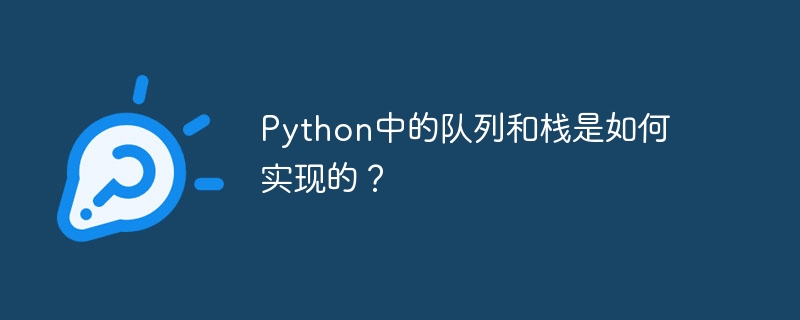Home >Backend Development >Python Tutorial >How are queues and stacks implemented in Python?
How are queues and stacks implemented in Python?
- WBOYWBOYWBOYWBOYWBOYWBOYWBOYWBOYWBOYWBOYWBOYWBOYWBOriginal
- 2023-10-20 08:13:071002browse

How are queues and stacks implemented in Python?
In Python programming, Queue and Stack are frequently used data structures. Queues and stacks have their own characteristics and uses, and Python provides some built-in data structures and methods to implement them.
The queue is a first in first out (FIFO) data structure, that is, the elements that enter the queue first are taken out first. The queue module is provided in Python to implement queues. The following is a sample code that uses the queue module to implement a queue:
import queue
# 创建一个队列对象
my_queue = queue.Queue()
# 入队操作
my_queue.put(1)
my_queue.put(2)
my_queue.put(3)
# 查看队列长度
print(my_queue.qsize()) # 输出3
# 出队操作
while not my_queue.empty():
item = my_queue.get()
print(item) # 依次输出1、2、3In the code, we first imported the queue module, and then created a queue object my_queue. Next, we use the put method to enqueue the queue. In the sample code, three elements, 1, 2, and 3, are entered into the queue respectively. qsizeThe method is used to return the length of the queue. Finally, use the while loop combined with the empty method to dequeue the queue until the queue is empty.
The stack is a Last In First Out (LIFO) data structure, that is, the last element pushed onto the stack is the first to pop out. In Python, you can use lists to implement stacks. The following is a sample code that uses a list to implement a stack:
# 创建一个空列表作为栈
my_stack = []
# 压栈操作
my_stack.append(1)
my_stack.append(2)
my_stack.append(3)
# 查看栈长度
print(len(my_stack)) # 输出3
# 弹栈操作
while my_stack:
item = my_stack.pop()
print(item) # 依次输出3、2、1In the code, we first create an empty list my_stack as the data structure of the stack. Next, use the append method to push the stack. In the sample code, the three elements 1, 2, and 3 are pushed onto the stack in sequence. Use the len function to get the length of the stack. Finally, use the while loop combined with the pop method to pop the stack until the stack is empty.
It should be noted that Python's list is actually a dynamic array that supports both queue and stack operations. When using a list to implement a stack, it is recommended to use the append and pop methods to push and pop the stack because it is more efficient.
In summary, queues and stacks in Python can be implemented through the queue module and lists. Queues use the first-in-first-out principle, while stacks use the last-in-first-out principle. Mastering the implementation methods of queues and stacks is very helpful for solving some specific problems.
The above is the detailed content of How are queues and stacks implemented in Python?. For more information, please follow other related articles on the PHP Chinese website!

